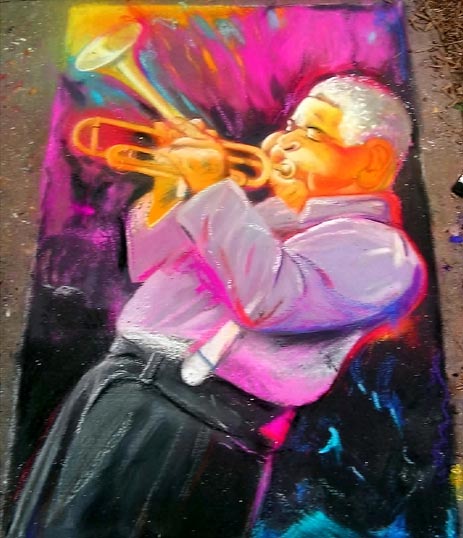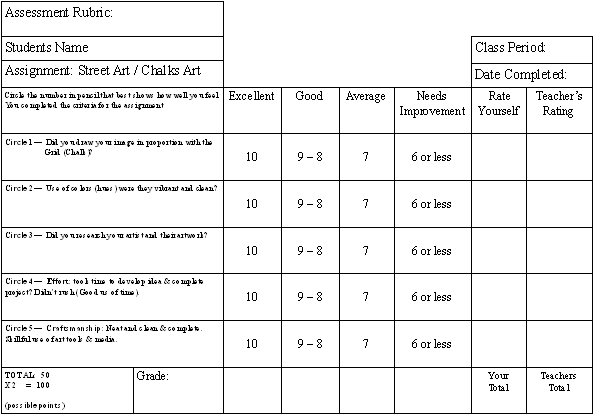 Shop On-Line at the Art of Essex
Shop On-Line at the Art of Essex
 Shop On-Line at the Art of Essex
Shop On-Line at the Art of Essex
|
|
Lesson Plan: Street Art / Chalk " A Jazzy
Renaissance" A Cultural and Media Experience Written by: Essex Garner LTC 8900: Artistic Thinking: Multimedia Applications for Teaching Art Cultural Unit Plan: A Jazzy Renaissance Art Strands: Making Art, Art History, Art
Criticism, Grade levels: 4 through 12 The Big Idea: This unit also provides your students with a unique opportunity for in depth discussion and discovery of the artistic changes from the past to their 21st century art classroom. Class time allotted for each lesson is one hour. The time for this lesson has to be lengthened once your students start their studio activities. Most people enjoy and appreciate Street Art or Chalk Art, Public Murals, and want to watch them be created. It takes a lot of courage to render an image onto the ground while getting covered in chalk, or recreating an old masterpiece or contemporary image on the pavement while people watch you. |
Ray Charles "Play That Song"
|
|
Conceptual Structure: Most people enjoy and appreciate Street Art or Chalk Art, murals, parades, and admire artistic creativity while watching artist work. It takes a lot of courage to render an image onto the ground while getting covered in chalk, or recreating old masterpieces or cultural images on the pavement while people watch you. The connected theme within this studio activity is "A Jazzy Renaissance". History has a way of reminding us of who we are, where we came from In some cases history reminds us of our phobias of other cultures, to include how we dealt with those issues as a society. Americaís most successful multicultural investment came about in New Orleans, Louisiana during the 19th and early 20th century. New Orleans at the time still had French and Spanish colonial roots, mixed with a resilience of African influences after the slave era. How do we atone for the numerous cultural struggles this nation has undergone? Thatís a pretty tall order, but making studentís awareness of "others" within our society and their unique struggles through artistic expression is a good place to start. Main Ideas: Strengthens the studentís knowledge in Art Appreciation, Cultural Diversity, and the important accomplishments of many ethic groups in American within the Visual and Performing arts. This lesson explores a different two-dimensional medium, and develops the studentís skills of using themes necessary to be incorporated into their artistic renditions. This lesson allows students to become evolved with community activities in arts, building on student understanding of how public memorials, street art, murals, and wall graphics fit within their communities. Students can draw on their personal experiences for inspiration or external sources like; Jazz Musicians Dizzy Gillepsi or Miles Davis and performance or literary artist, contemporary Hispanic, African, and past or modern cultural or social themes. Students also learn to shed their inhibitions of creating artwork in public spaces while they drawing. While they are making their works, they are in fact on stage like any performing artists. The students will examine two-dimensional concepts that fall under Art Censorship, and demonstrate that their work has a social relevance and wouldnít be considered patiently offensive to other ethnic groups. Other artists that can be explored within these cross cultural connections are: Frida Kahlo or Diego Rivera, and artists of the Harlem Renaissance and their works like (Romare Bearden or Jacob Lawrence).
|
Jacob Lawrence Boy With Kite (Heroshima Seriers) Eample Student work |
|
1. Goals and Objectives:
The students will examine two-dimensional concepts that fall under art censorship, and the struggles many musicians faced either through segregation or Jim Crow laws. The students will demonstrate that their work wouldnít be patiently offensive in public domains. Students will also develop their map reading skills within geographical and historical markers of information.
|

Dizzy |
|
2. Lesson Concepts:
|
Cedar Hill Elementary School Art Club Jazzfest Chalk Art work. Capitol Jazz Fest 2010, Memorial Park. Jefferson City, Missouri |
3. Instructional
critical studies:
4. Art making actvities (What to do):
|
Miles Davis Eample Student work |
5. What you will need:
6. This curricular lesson fosters skills for the conceptual age through the studentís investigative research, connecting the past visual culture with the present, and makes art fun (Although your kids will get a little dirty. By connecting these concepts, each student will walk away with a better understanding and appreciation of a wonderful cultural era, and a hand on approach to learning about the world around them. Once the project is completed the students will also understand other diverse groups, improve their map skills, and how to record their work in a digital environment. This lesson has one final teachable idea because the student and audience must learn to appreciate the culture of others and their work will last only for a short while. So and live in the moment, and donít become to enamored with your creation. After most projects are completed, their life expectancy is only a matter of hours, so take good picture. Hopefully it will not rain on the day you plan this event. Types of Chalk, There are three basic types of chalk that are effective for sidewalk art. They range from the cheaper version commonly used in elementary and secondary schools to the compressed Pastels.
1. Sidewalk Chalk, sku# 664946: Price: $3.99, Description: 52 Jumbo Sidewalk Chalk in assorted colors. Chalk sticks 1'' x 4 1/2'í, Colors Assorted, Size 52 Count. This is the sets commonly used for elementary and secondary education, but will not give color intensities of most professional works.
2. Dustless Chalk, sku# 601880 : Price: $0.77, 16 Pieces, assorted
3. Multi Pastel Compressed Chalk (I use this one professionally) Description: This package of Multi Pastel Compressed Chalk has vibrant colors and the square sticks are ideal for Landscapes, Portraits, Still Life, Multicultural, Global Art Projects, Traditional Sketches and more. |
2 inches on the paper = 2 feet outside on the ground
Hobby Lobby item numbers
|


Creativity Connections & Classroom Implications & Applications
![]() Blog
Information for Artistic Thinking
Blog
Information for Artistic Thinking

Useful Internet Links:
Beever, J (2009). Pavement Drawings, Wall Murals, Fine Art
Paintings. Retrieved September
23, 2010, from
http://users.skynet.be/J.Beever/
Capital Arts, J. (2010). Capital City Counsel on the Arts,
Capital Street Art for Schools,
Retrieved September 23, 2010, from
Capital Street Art for
Schools
Celebrate Black History: The Harlem Renaissance (2009),
November 9, 2010, from
Celebrate Black History: The Harlem Renaissance
Charlie Parker (Frank Driggs
Collection) (2009);
Retrieved September 23, 2010, from
http://www.pbs.org/jazz/biography/artist_id_parker_charlie.htm
Garner, E. (2010). Capital Jazzfest and Street Art 2010,
Constructivist Wall Graphics:
Retrieved September 23, 2010, from
https://essexgarner.com/chalkart2010essexgarner.htm
Lawrence, J. (1997). Toussaint LíOuverture Series by Jacob Lawrence.
The High Museum,
"Over the Line: The Art and Life of Jacob Lawrence".
Retrieved November 9, 2010, from
http://www.alitashkgallery.com/lawrencetl/
McNulty, Ian (2010). History New OrleansFrenchQuaters.com. First
Notes: New Orleans and the Early Roots of Jazz.
Retrieved October 29, 2010, from
http://frenchquarter.com/history/JazzMasters.php
New Orleans Website Directory (1999). New Orleans & Louisiana Bands
& Musicians. Retrieved
November 9, 2010, from
http://neworleanswebsites.com/cat/en/mu/m-bm/m-bm.html
Additional Information:
|
|
|
|
|
|
 |
|